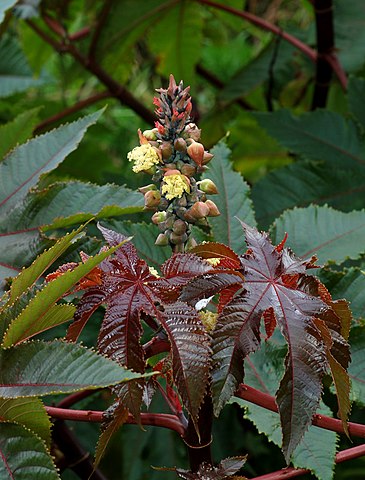Growing healthy castor bean plants (Ricinus communis) can add a bold and tropical element to your garden. These fast-growing plants are known for their large, palmate leaves and unique seed capsules. However, it’s crucial to handle them with care, as all parts of the castor bean plant contain ricin, a highly toxic protein. Here’s the ultimate guide to help you grow healthy castor bean plants:
Page Contents
Toggle1. Varieties of Castor Bean Plants:
- ‘Carmencita Pink’: Compact and ornamental with pinkish-red seed capsules.
- ‘Gibsonii’: Dwarf variety with red-tinged foliage and smaller seed capsules.
- ‘Zanzibarensis’: Giant variety with massive leaves, reaching up to 3 feet in diameter.
2. Planting Location:
- Sunlight: Castor beans thrive in full sun but can tolerate partial shade.
- Soil: Well-draining soil with a pH between 5.5 and 6.5. They are adaptable to a variety of soil types.

3. Planting Time:
- Sowing Seeds: Start seeds indoors about 6-8 weeks before the last expected frost. Transplant seedlings outdoors once the soil has warmed.
4. Planting Method:
- Seeds: Plant seeds about 1 inch deep in well-draining soil. Water consistently until seedlings emerge.
5. Watering:
- Regular Watering: Castor beans prefer consistently moist soil. Water when the top inch of soil feels dry.
- Avoid Waterlogged Soil: Ensure proper drainage to prevent waterlogged conditions.
6. Mulching:
- Mulch: Apply a layer of mulch to retain soil moisture and suppress weeds.
7. Support:
- Staking: As castor beans grow tall, they may need staking to support their height, especially in windy areas.
8. Fertilizing:
- Rich Soil: Castor beans benefit from well-amended soil. Add organic matter, like compost, before planting.
- Fertilizer: A balanced, all-purpose fertilizer can be applied at the beginning of the growing season.
9. Pruning:
- Pinching Tips: To encourage bushier growth, pinch the tips of young plants when they are about 12 inches tall.
10. Harvesting Seeds:
- Timing: Allow seed capsules to mature on the plant until they turn brown and start to crack open.
- Gloves: Wear gloves when handling seeds, as they contain ricin. Remove seeds carefully and dispose of them properly.
11. Overwintering:
- Tender Perennial: In warmer climates, castor beans may act as tender perennials. Provide protection in colder months.
12. Pest and Disease Management:
- Aphids: Keep an eye out for aphids and hose them off with water or use insecticidal soap.
- Powdery Mildew: Ensure good air circulation to prevent powdery mildew.
13. Toxicity Awareness:
- Caution: All parts of the castor bean plant are toxic if ingested or if there is contact with broken seeds. Handle with care, especially if you have pets or small children.
14. Companion Planting:
- Consideration: Due to their toxicity, it’s essential to consider companion planting carefully. Plant them in an area where contact with people and pets is minimal.
By following these guidelines, you can successfully grow healthy castor bean plants and enjoy their striking presence in your garden. Always be mindful of their toxicity and take necessary precautions to ensure safety.











